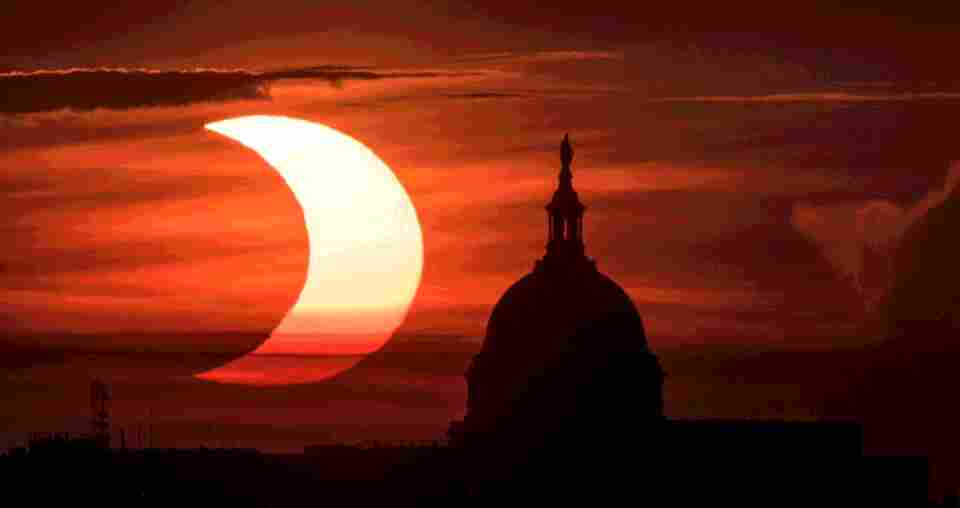Technology
A ‘mini’ solar eclipse will blot out Sun THIS week – how to watch it live

THE first solar eclipse of 2022 arrives this week.
A partial solar eclipse will be visible over parts of Antarctica, South America, and the Pacific and Atlantic oceans on April 30.
EPAA partial solar eclipse as the sun rises to the left of the United States Capitol Building in June 2021[/caption]
And while skygazers in the U.K. and U.S. won’t get to see it in person, they can watch a live stream of the rare celestial event.
Solar eclipses occur when the Sun, Moon and Earth align, casting a shadow on Earth.
A partial eclipse takes place when a portion of the Sun is obscured, plunging a section of it into darkness when viewed from Earth.
At its peak, Saturday’s eclipse will see roughly 65 per cent of the Sun blotted out by the Moon, according to Nasa.
Read more about space
Its visibility – and how much of the Sun is covered – will vary depending on where you’re viewing it from.
Partial eclipses last longer than total solar eclipses, the next of which won’t come around until April 2023.
According to timeanddate.com, this week’s partial eclipse will first be visible at 2:45 p.m. EST (7:45 p.m. UK time).
It will hit its peak a couple of hours later before ending at 6:37 p.m. EST (11:37 p.m. UK time).
Most read in News Tech
The eclipse coincides with the second new moon of April, also called a Black Moon.
You can watch it on a live stream that will kick off on the YouTube channel Gyaan ki gareebi Live when the eclipse begins.
Solar eclipses are relatively rare, with between two and five occurring per year. Each is visible only in a limited area.
On October 25, another partial eclipse will be visible from Europe, Northeast Africa, the Middle East and West Asia, according to NASA.
What is a solar eclipse?
A solar eclipse is a stunning celestial event that sees the Sun blocked by the Moon – casting a shadow on the Earth.
This partial or total blockage happens when the Sun, Moon and Earth line up.
When the Moon comes between the Earth and the Sun during a new moon phase, it blocks the light and forms a shadow across the globe.
What are the different types of solar eclipses?
There are four types of solar eclipse.
Total solar eclipse
This occurs when the orbital planes align and the Moon appears to completely block out the light from the Sun.
The Sun is exactly 400 times bigger than the Moon but it’s also 400 times further away from the Earth.
These are the perfect ratios for the moon to completely eclipse the sun, provided the alignment on the Earth’s surface is exactly right.
When the total solar eclipse occurs – when the Sun is completely covered – the “corona” is revealed, which is the outer atmosphere of the Sun.
Partial solar eclipse
This happens when a part of the Sun is always in view, creating a “penumbra” or partial shadow.
A partial eclipse means the centre of the Moon’s shadow misses the Earth, but it still creates a spectacular effect for sky gazers.
The amount of Sun which is obscured by the Moon depends on where the person viewing the event happens to be.
This can range from a relatively small bite-sized chunk appearing to the Sun taking on a slim crescent-shape.
Annular solar eclipse
Annular solar eclipses are rare and considered as a sort of variant on a partial solar eclipse.
An annular solar eclipse appears similar to a total eclipse in that the Moon appears to pass centrally across the Sun, creating a “counterfeit twilight”.
The event occurs when the three objects are not quite fully aligned with the Moon being vastly smaller than the Sun, and the Sun is not completely covered.
As Space.com explains: “During such an eclipse, the antumbra, a theoretical continuation of the umbra, reaches the ground, and anyone situated within it can look up past either side of the umbra and see an annulus, or “ring of fire” around the Moon.
“A good analogy is putting a penny atop a nickel, the penny being the Moon, the nickel being the Sun.”
Hybrid solar eclipses
These are also known as annular-total (“A-T”) eclipses.
They occur when the moon’s distance is near its limit for the umbra to reach Earth.
An A-T eclipse usually starts as an annular eclipse due to the tip of the umbra falling just short of making contact with Earth; then it becomes total, because the curvature of the planet reaches up and intercepts the shadow tip near the middle of the path, then finally it returns to annular toward the end of the path.
Of all solar eclipses, about 28 per cent are total; 35 per cent are partial; 32 per cent annular and just five per cent are hybrids.
Read More on The Sun
How often are solar eclipses?
Eclipses don’t happen at every new moon.
The number of times a solar eclipse occurs varies but usually between two and five take place each year.
On average, a total eclipse occurs somewhere on Earth about every 18 months.
Read all the latest Phones & Gadgets newsKeep up-to-date on Apple storiesGet the latest on Facebook, WhatsApp and Instagram
We pay for your stories! Do you have a story for The Sun Online Tech & Science team? Email us at tech@the-sun.co.uk

